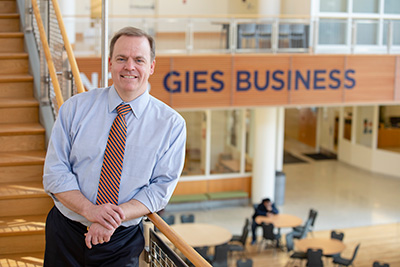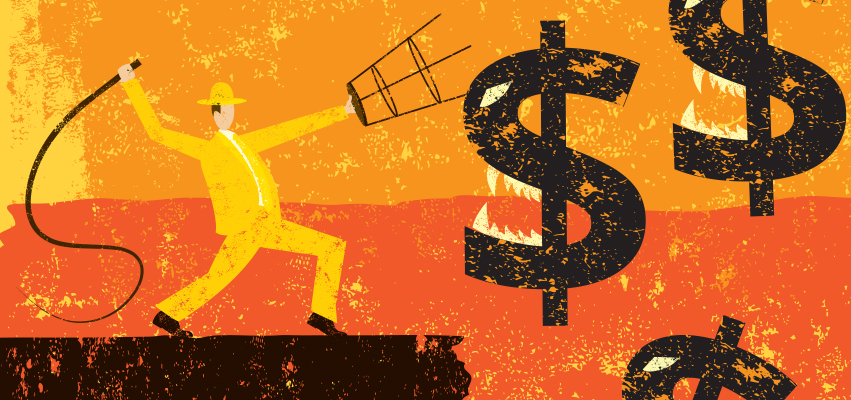
Welcome back to Peoria Magazine’s Econ Corner, a recurring feature in which we pose questions to experts about various economic issues and how they affect our lives and careers here in central Illinois. Dr. Jeffrey R. Brown, Dean of the Gies College of Business at the University of Illinois at Urbana-Champaign, Research Associate of the National Bureau of Economic Research, founding Director of the U of I’s Center for Business and Public Policy, and former member of the White House Council of Economic Advisers provides this month’s analysis.
Peoria Magazine (PM): It has always been a balancing act for the Federal Reserve — how to take action to slow the economy and tame inflation without courting recession. That said, the Fed now has taken its most aggressive interest rate-raising action to date, producing this recent headline in the New York Times: “The Economy Is Already Cooling, So Why Is the Fed Dousing It With Cold Water?” The question is: How do we know when enough is enough?
Jeffrey Brown (JB): The honest answer is that nobody knows with certainty. Macroeconomic forecasting models are very helpful in providing general guideposts, but they are simply not capable of providing precise GPS coordinates to land the economy exactly where we want it to land. The reason is that the global economy is extraordinarily complex, with trillions of transactions and decisions being made every day by billions of people around the world.
Trying to represent all that complexity with a simple macroeconomic model to guide policy is difficult, and that means that we almost never get it exactly right. Indeed, there are multiple models out there, each of which will give a slightly different policy prescription. Add in the fact that policymakers do not always agree on the relative importance of inflation versus employment, and it is natural that we see a wide range of views about what the Fed should do.
The Fed has admitted that they got it wrong last year by underestimating the extent to which high and persistent inflation would take root. As a result, we are now dealing with the highest rate of inflation we have seen in the U.S. in approximately four decades. The 0.75 percentage point rate increase in June was an attempt to bring inflation down, and the Fed has signaled another large increase in July. Such rate increases will undoubtedly help fight inflation, but it definitely increases the risk of a recession. Unfortunately, it takes time for the full effect of a rate increase to work through the system, so it could be several months before we know whether they did too little, too much, or just enough.
PM: What economic indicators should we be paying the most attention to in terms of whether we’ve reached that “enough is enough” stage? The direction of GDP, unemployment, real spending power, consumer confidence, the stock market? Please elaborate.
JB: I would first note that there is not universal agreement on what “enough” even means in this context. Unfortunately, there is a fundamental tradeoff between employment levels and inflation. Some policymakers would be willing to accept higher unemployment rates if it kept inflation low and stable, while others would happily accept a higher inflation rate if accompanied by lower unemployment. So, part of the disagreement we will inevitably see in the months ahead is due to different preferences.
As far as indicators go, the general public should pay close attention to the GDP numbers, inflation and key labor market statistics such as new job openings, hiring and labor force participation rates. There are a number of other measures that economists will focus on due to their ability to inform the likelihood of a recession, but these are less informative to non-economists. An example is the relationship among interest rates at varying time horizons, known as the yield curve, which is used by some economists as a tool for assessing the likelihood of a recession.
PM: The University of Michigan’s Index of Consumer Sentiment just fell to its lowest level ever. Are consumers right to feel the way they do, or are they panicking, exaggerating the negatives and dismissing the positives in the economy?
JB: It has become cliché to say it, but the past 2.5 years have truly been unprecedented. Consumers have been battered about by circumstances beyond their control, including a partial economic shutdown, concerns about workplace health and safety in the face of COVID, and a divisive election.
Then, just as things started to feel as if they were normalizing due to the availability of vaccines, we were hit with a war in Europe, massive supply chain disruptions, and rapidly rising prices.
More than half of the U.S. population has never lived in a period of inflation as high as it is today. So, after living their entire lives in a period of stable prices, many consumers now feel as if they are standing by helplessly as the purchasing power of the dollar drops. They see how expensive it is to fill their gas tank, and they worry they are falling behind.
So no, consumers are not panicking or exaggerating. Rather, they are responding in a very authentic way to the daily reminder that prices are rising rapidly.
Consumer spending is about 70% of GDP, so we do need to worry about a decline in consumer confidence. If consumers respond to this stress and uncertainty by cutting back spending, it will slow GDP growth and potentially contribute to a recession.
PM: Given the path we seem to be on, where would you put the odds of entering a period of stagflation?
JB: Stagflation is a situation in which we simultaneously experience high inflation, slow economic growth, and high unemployment. It would be a terrible outcome, with people losing jobs at the same time the cost of living is rising. Indeed, this is why some folks refer to the sum of the inflation rate and the unemployment rate as the “misery index.”
I believe that the risk of stagflation, while not zero, is very, very low. In contrast, I think it is more likely than not that we will experience a recession, but my hope is that it is both mild and that it is successful in bringing inflation back down to below 3%.




